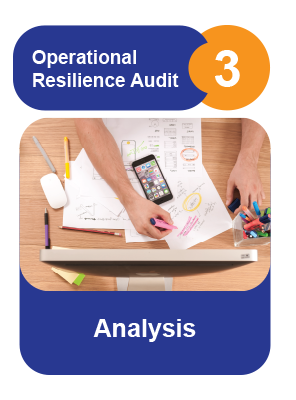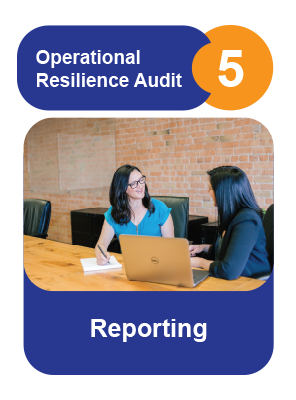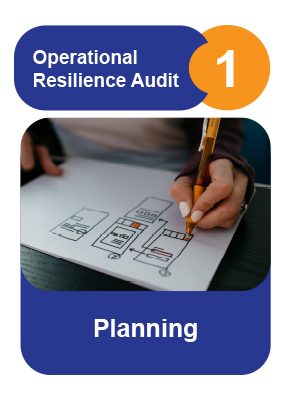ORA Planning [3] Data Analysis
Operational Resilience Audit Planning Step
Data Analysis
 |
 |
 |
 |
 |
 |
 |
Please feel free to send us a note if you have any of these questions. |
 |
Posts about:

 |
 |
 |
 |
 |
 |
 |
Please feel free to send us a note if you have any of these questions. |
 |

 |
 |
 |
 |
 |
 |
 |
Please feel free to send us a note if you have any of these questions. |
 |

Detailed Data Collection Steps
|
|
|
 |
 |
 |
 |
 |
 |
 |
Please feel free to send us a note if you have any of these questions. |
 |

Preparation for Audit
|
 |
 |
 |
 |
 |
 |
 |
Please feel free to send us a note if you have any of these questions. |
 |

While professionals generally still prefer to attend an onsite classroom-based course with a facilitator or instructor being present, (electronic) online video face-to-face workshop practices are fast gaining momentum as a participant prefer to acquire the learning over some time. The other preference is reducing travelling as remote work or attending courses in the office is becoming the norm.

The roadmap above is a snapshot of what you can expect from the programme. It is divided into the respective modules 1 to 4. Find each module's syllabus by clicking the four [Course Content] buttons. The content has been carefully crafted to ensure that your participation and outcome match each day of the ORA-5000 OR Audit Expert competency level.
Click any of the four buttons [Course Requirement] to learn more about your participation and involvement in this course.
The course fee is SGD 3,850 for 100% online and SGD 4,150 for online + onsite, payable before the class starts.
|
Module |
 |
![[BL-ORA] [3] M2 What is ORA-300?](https://no-cache.hubspot.com/cta/default/3893111/73647d96-98df-4207-a85c-b9f80c790cff.png) |
 |
![[BL-ORA] [4] [5] M4 What is ORA-5000?](https://no-cache.hubspot.com/cta/default/3893111/be84739a-0b28-43ff-92f2-156d519e2d32.png) |
|
Course Content |
 |
 |
 |
 |
|
Course Requirement |
 |
 |
 |
 |
| Module | Mode of Study | Flexible (Hours) | Mandatory & Fixed Timing (Hours) |
 |
Online Self-pace eLearning (Eight 1-Hour Self Pace eLearning Classes) | 1 | 8 (1-hour self-pace eLearning sessions) |
![[BL-ORA] [3] M2 What is ORA-300?](https://no-cache.hubspot.com/cta/default/3893111/73647d96-98df-4207-a85c-b9f80c790cff.png) |
Facilitated Online Workshop (1 Hour Self-Reading + 6 Hours Scheduled Online Classes) |
1 | 6 (3-hour x 2 separate sessions) |
 |
Online Training and Discussion Workshop (2 Hours Reading/ Assignment + 3-Hour Schedule Online Classes) | 2 | 6 (3-hour x 2 separate sessions) |
![[BL-ORA] [4] [5] M4 What is ORA-5000?](https://no-cache.hubspot.com/cta/default/3893111/be84739a-0b28-43ff-92f2-156d519e2d32.png) |
Online Training and Discussion Workshop (2 Hours Self Reading/ Assignment + 3 Hours Schedule Online Classes) | 2 | 6 (3-hour x 2 separate sessions) |
| Total Hours | 6 | 24 | |
|
|
|||
|
Attempt Qualifying Examination |
Question | Duration | |
 |
Operational Resilience Audit Expert (ORAE) after ORA-5 course |
100 | 2 and 1/2 hours |
 |
Operational Resilience Audit Specialist (ORAS) after ORA-3 course | 100 | Completed during the Module 1 eLearning Module |
 |
Operational Resilience Certified Planner (ORCP) after ORA-2 course | 50 | 1 and 1/2 hours |
Post-COVID-19, various regulatory developments have impacted the financial services industry, such as refining the management of disruptions, increasing interconnectedness and third-party/ outsourcing dependencies and dependencies on IT. This emphasises that operational resilience will remain a significant concern for the board, regulators, policymakers, investors and customers.
The challenge is organizations' approaches to dealing with differing regulations globally. In terms of resilience structure, organizations have looked at their governance frameworks and ensured they are fit for purpose. They utilise stress and scenario testing to assess their capabilities, which is more than their existing business continuity and crisis management programs.
Click the icon on the right to learn more about the difference between Blended Learning and Hybrid Learning offered by BCM Institute.
The entire process is redesigned with pre-reading (at your own time and pace) and preparatory work (rather than one hour doing the work in class) supported by proprietary guidance notes. In fact, after several cohorts, the content from those who had attended our other advanced-level courses highlights a better way to provide the same outcome.
Instructors: Note that instructors delivering the modules will remain the same as those providing the onsite training. At BCM Institute, most instructors still practise BCM and risk management professionals (in this case, operational resilience and operational risk) with a minimum of 12 years of direct BCM experience as they hold regional or global resilience responsibilities.
International Participation: Another significant change will be the participation of more international delegates compared to the traditional majority of Asian participants. Be expected to discuss and work as teams from around the world.
 Be expected to have more pre-readings as the objective is to ensure that knowledge that could be acquired via reading should be done outside the training session. More time is allocated to sharing experiences between the participants and facilitators.
Be expected to have more pre-readings as the objective is to ensure that knowledge that could be acquired via reading should be done outside the training session. More time is allocated to sharing experiences between the participants and facilitators.
Schedule for Courses: This is the schedule and dates for the start of the next course. Click "ORA-5000 Course Calendar" to learn more about the "RUNs" for the year.